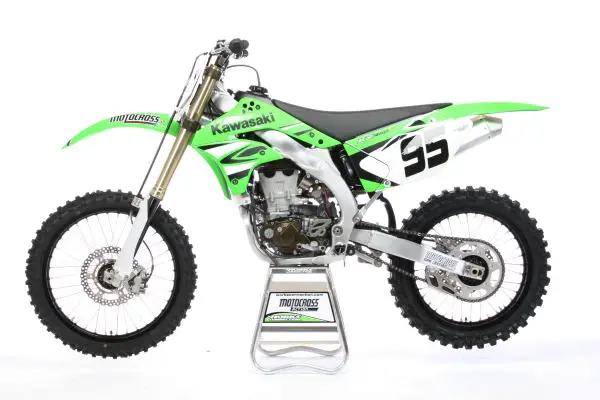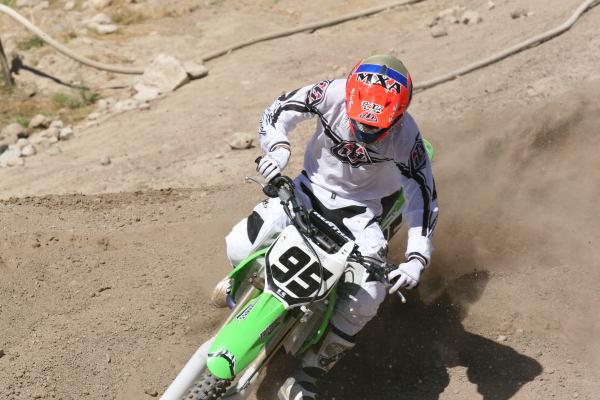2008 RACE TEST KAWASAKI KX450F
If there is a cause celebre for the 2008 motorcycle manufacturers, it is the total focus on making the new engines easier to use, more controllable and smoother. Kawasaki has joined the parade. They gave up the horsepower advantage they had in 2007 to go for a broad, mellow and less violent power delivery.
While engine management issues got the most attention in Japan this year, there was a secondary issue?frame flex. And we aren’t talking about eliminating frame flex, but feeding it back into the latest generation of ultra-rigid cast, forged and extruded aluminum frames. Kawasaki is also beating this drum for 2008 (with a deceptively simple solution).
When you factor in the day-to-day work of the manufacturers’ R&D departments, you get 2008 machinery that is more evolutionary than revolutionary. Kawasaki hasn’t thrown the baby out with the bath water, but rather added some epsom salts. The goal is to improve the breed, fix hereditary flaws and increase overall reliability.
Kawasaki engineers have made the changes, but now it’s time for the MXA wrecking crew to evaluate how well the fixes to the 2008 Kawasaki KX450F work.
Q:WHAT WAS KAWASAKI TRYING TO ACHIEVE ON THE 2008 KX450F?
A:You don’t need a drum major to tell you what tune Kawasaki’s R&D department was marching to. Here’s the list:
(1) Power. It’s no secret that the 2007 KX450F had the best power output in the class. Compared to the 2006 model, the 2007 KX450F made more power and torque at every point on the powerband (from 4500 rpm all the way up to 10,500). Power was up three horsepower (from 2006 to 2007) and torque was up two foot-pounds. So, what about 2008? Would it shock you to discover that Kawasaki gave up all of the ’07 horsepower and torque gains to return to the power numbers of 2006? It’s true. Peak horsepower is down over two horsepower and torque is down one foot-pound.
(2) Handling. Anyone who has ridden a KX450F knows that it has a push in the center of corners and a tendency to stand up whenever there isn’t a berm to lean against. Kawasaki’s engineers believe that this understeer is caused by frame rigidity. They feel that the rigidity overpowers the frame’s geometry. For 2008, they devised a way to allow the frame to be more forgiving.
(3) Suspension settings. The original 2006 KX450F was undersprung and wallowed under a load. For 2007, Kawasaki changed the shock damping and the rising rate, but they didn’t go far enough. This year, the KX450F gets stiffer valving (front and rear) to try and keep the big Kwacker from hunting and searching on fast straights.
Q:WHAT DID KAWASAKI CHANGE ON THE 2008 KX450F ENGINE?
A:Kawasaki made a series of changes?one major for performance, and four minor for durability. Here is the list:
Performance. To tame the power pulses, Kawasaki increased the flywheel weight to maximize the crank’s moment of inertia. In addition, web-shaped crank webs make the power hook up with less input.
Durability. The connecting rod is cast with a special surface coating to reduce friction at both ends. A 2mm larger oil pump rotor spins at a different rpm than last year to improve oil circulation throughout the top end. The piston cooling jet, a small nozzle that sprays an oil mist under the piston crown, has been redirected to get the oil to the best spot. Finally, a fifth bolt was added to the oil pump cover to eliminate leakage around the seal.
Q:IS THE 2008 KX450F FASTER THAN THE 2007 KX450F?
A:The short answer is no. Based on the fact that Kawasaki gave up both horsepower and torque, there is no way that it could be faster…at least in a drag race. But, the drafting board guys at Kawasaki Heavy Industries were looking for a different definition of fast: a definition that replaces the word “fast” with “usable.”
On this front Kawasaki has succeeded. There is less bark to the 2008 engine. It comes on smoother, has a more linear power delivery and is easier for mortal man to use. Pro riders will want the grunt of the 2008 engine, but most riders will like the toned down feel of the ’08 engine.
Kawasaki made a few techno-touches to the top-end, like putting an anti-friction coating on the intake ports and revising the ignition curves, but every mod was programmed to produce more usable power as opposed to more power.
Q:IS THE 2008 ENGINE BETTER THAN THE 2007 ENGINE?
A:We loved last year’s powerband. The ’07 engine was a diesel locomotive: it chugged, it lugged, it churned.
The 2008 engine isn’t as good from a statistical standpoint (or for riders looking for pure horsepower), but even though the ?08 KX450F isn’t faster, it is better for a wider audience. How so? The more rheostat-style of power off the bottom, crisper throttle response through the middle and detuned hit make the KX450F more of a rider’s bike than last year. The power can be used more efficiently because there is less of it?but not so much less that any test rider accused the 2008 KX450F of being slow.
It’s still fast, but more like Mama bear’s porridge (as in, not too hot to handle).
Q:HOW IS THE KX450F JETTING?
A:It is ballpark. We made the requisite fuel screw adjustments, but stuck pretty close to stock.
The stock jetting is as follows:
Main: 175
Pilot: 42
Needle: NCVR
Clip position: Fourth from top
Fuel screw: Two turns
Leak jet: 55
Notes: Thanks to a new ignition curve, the KX450F starts much easier than last year.
Q:WHAT WAS OUR BEST FORK SETTING?
A:The Kayaba forks get Kashima-coating on the inside surfaces of the outer fork tubes to lessen stiction.
For hard-core racing we recommend this fork setup:
Spring rate: 0.47 kg/mm
Oil height: 340cc
Compression: Ten clicks out
Rebound: Ten clicks out
Fork leg height: 5mm up
Notes: In 2007 we slowed the rebound down from the stock ten clicks out to six clicks to help the forks follow the ground better. For 2008, we run the rebound at ten clicks out.
Q:WHAT WAS OUR BEST SHOCK SETTING?
A:With stiffer damping for 2008, the rear suspension is moving towards the acceptable level (especially when compared to the first version). The rising rate was changed in 2007, and the valving gets a remake for 2008. We’d still like Kawasaki to go stiffer on the rear shock, either with the rising rate linkage or the shock spring. Although the wallowing has been reduced, test riders still complain that the rear end seesaws across rough ground (and is constantly searching for a stable platform position). Getting the rear to take a set and remain stable is job one.
For hard-core racing we recommend this shock setup:
Spring rate: 5.5 kg/mm
Race sag: 100mm
Hi-compression: One turn out
Lo-compression: Eight clicks
Rebound: Eight clicks
Notes: The 2008 KX450F is very sensitive to balance between the front and rear. Just like in 2007, we think that switching to the aftermarket Pro Circuit linkage is a good idea. It stiffens the initial part of the shock stroke to hold the bike in a more consistent position. On the downside, it drops the rear down 12mm, which kicks the head angle out. We compensate for this by sliding the forks up 2.5mm more to bring the steering back to optimum.
Q:HOW DOES THE 2008 KX450F HANDLE?
A:This is not a great handling bike. When set up even slightly wrong it has a big hobby horse feel to it. There is a lot of fore-and-aft movement that causes the geometry to be in flux at the moment when you want it to be fixed. That said, we think that Kawasaki’s low-tech frame fix did wonders for the overall feel of the KX450F’s steering input. Where Yamaha, Honda and Suzuki massaged the tube diameters and wall thicknesses of their frames for 2008, Kawasaki went down to the hardware store and bought a long bolt and a couple of spacers. By using a longer bolt on the front motor mount, Kawasaki was able to feed flex into the front down tube. Lessening the torsional rigidity seems to make the front wheel track more accurately.
It’s a weird Band-Aid, but you can feel it.
Q:WHAT CHANGES WOULD WE MAKE TO THE 2008 KX450F?
A:The 2008 KX450F can be improved. All it takes is a checkbook.
Gearing: Although the KX450F got a five-speed tranny in 2007, it is really the same-old 2006 four-speed gearbox (with a fifth gear grafted on the high-end). For a motocrosser, the switch from four to five didn’t really solve the KX450F’s big gaps between gears. The poorman’s gearbox fix is to add one tooth to the rear sprocket. That will bring second gear down, move third gear in closer and lessen the gap between third and fourth. The added plus is that you have a fifth gear to use on the freeway.
Twenty-two millimeter offset triple clamps: Even though the 2008 frame is more forgiving than the 2007 frame, we still prefer to run 22mm triple clamps. They lessen the understeer and stop the push.
Pro Circuit KX shock linkage: We like what the Pro Circuit link does for the rear of the KX450F. It lowers it to a more usable seat height, stiffens the initial part of the stroke, and makes the chassis hold its balance through the bumps.
Q:WHAT DID WE HATE?
A:The hate list:
(1) Tires: If we were R&D’ing a bike that was reluctant to turn, we would not spec the new generation of wide tires. On our KX450F we replaced the wide 120/80 rear tire and fat 90/100 front tire with a narrower 110/90 rear and 90/100 front. The smaller and rounder knob profiles of the smaller tires allow the bike to roll into turns with less chug.
(2) Shifting: Even though the KX450F has a new shift cam and wider shift drum track, this is a balky bike to shift under a load.
(3) Gearing: The quick fix is one tooth on the rear.
Q:WHAT DID WE LIKE?
A:The like list:
(1) Wheels: Black rims lose their luster after a few rock dings and tire iron grooves mark up the black anodizing.
(2) Handlebars: There is a healthy contingent of MXA test riders who still prefer 7/8-inch handlebars.
(3) Radiator shrouds. The black portion of the radiator wing has been replaced with an all-green motif.
(4) Options: Your local Kawasaki dealer can order you a heavier flywheel, oversized handlebar mounts, steel rear sprockets, solid brake rotors and a manual decompression lever.
Q:WHAT DO WE REALLY THINK?
A:The MXA wrecking crew is conflicted about the 2008 KX450F. The 2007 model’s greatest charm was its incredibly broad and powerful engine. It seems wrong to give up so much horsepower and torque. It sissifies the big green monster. On the other hand, the sissy engine is easier to ride. When the mellower powerband is combined with the improved suspension and decreased frame rigidity, the 2008 is a better bike for the vast majority of riders?just not for faster riders.








Comments are closed.